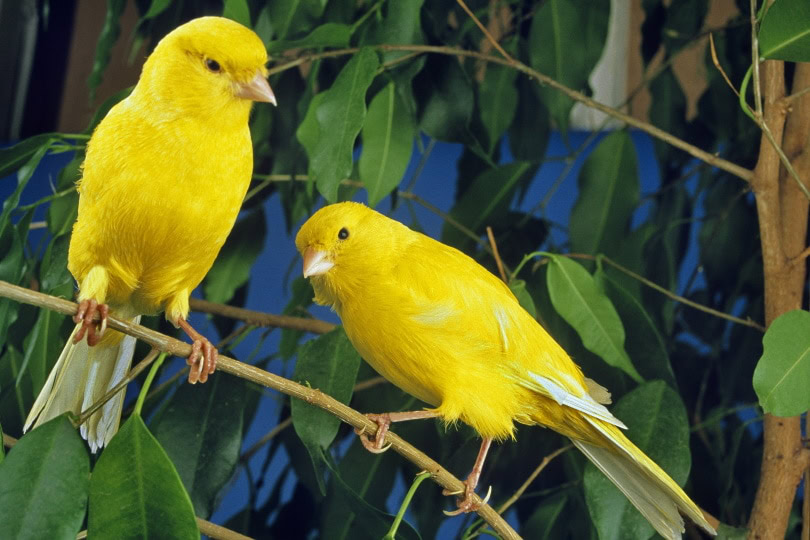providencemarianwood.org – Canaries (Serinus canaria) are small finches native to the Canary Islands, Azores, and Madeira archipelagoes. Originally drab greenish-brown birds, selective breeding has produced a dazzling array of colors, patterns, and song variations, making them popular cage and aviary birds worldwide. Their cheerful songs and relatively easy care have cemented their place as beloved companions for centuries.
Physical Characteristics: Small Size, Big Voices
Canaries share typical finch characteristics, with some distinct variations due to selective breeding:
- Small Size: Canaries are small birds, typically measuring 12-14 cm (4.7-5.5 inches) in length.
- Conical Beak: They possess a strong, conical beak well-suited for cracking seeds.
- Plumage: Wild canaries are greenish-brown with yellowish underparts. Domesticated canaries, however, come in a vast array of colors, including yellow, orange, red, white, and various combinations and patterns.
- Song: The most prized characteristic of canaries is their complex and melodious song. Males are the primary singers, using their songs to attract mates and establish territories.
Classification and Origins: From Wild Finch to Domesticated Companion
Canaries belong to the family Fringillidae, the finch family. Their wild ancestor, the Atlantic Canary (Serinus canaria canaria), is still found in the Canary Islands and surrounding archipelagos. Domesticated canaries are believed to have originated from selective breeding efforts beginning in the 17th century.
Habitats and Distribution: From Islands to Cages
Wild canaries inhabit a variety of habitats in their native islands:
- Woodlands: They prefer open woodlands and forests with plenty of shrubs and trees.
- Semi-open Areas: They also inhabit semi-open areas with scattered trees and bushes.
Domesticated canaries are found worldwide in cages and aviaries.
Diet and Foraging: Primarily Seed Eaters
Wild and domesticated canaries share a similar diet:
- Seeds: Seeds are the primary food source, especially canary seed, millet, and other small seeds.
- Fruits and Vegetables: They also enjoy small amounts of fresh fruits and vegetables.
- Greens: Fresh greens like lettuce, spinach, and dandelion greens provide essential vitamins and minerals.
Behavior: Social Birds with Distinct Songs
Canaries are generally social birds, often forming small flocks in the wild.
- Song: As mentioned, the male canary’s song is a complex and varied sequence of trills, warbles, and whistles. Different breeds have been developed for specific song qualities.
- Social Interactions: They communicate with each other through calls and displays.
- Dust Bathing: They regularly take dust baths to maintain their plumage.
Reproduction: Breeding in Captivity
Canaries breed readily in captivity with proper care:
- Breeding Season: Breeding season is typically in the spring and summer.
- Nesting: They build cup-shaped nests from soft materials like cotton, yarn, and nesting fibers.
- Eggs: The female lays several small, speckled eggs.
- Incubation: The female incubates the eggs for about two weeks.
- Chick Rearing: Both parents feed the chicks regurgitated seeds and insects.
Canary Breeds: Diversity Through Selective Breeding
Centuries of selective breeding have resulted in a wide variety of canary breeds, classified into three main types:
- Color Canaries: Bred for their plumage color, including various shades of yellow, orange, red, white, and combinations thereof.
- Type Canaries: Bred for their physical conformation, such as the crested canary, the frilled canary, and the border fancy canary.
- Song Canaries: Bred for their singing ability, with distinct song variations such as the German Roller, the Spanish Timbrado, and the American Singer.
Historical Significance: Canaries in Coal Mines
Canaries have a unique historical significance:
- Coal Mine Safety: Canaries were historically used in coal mines as early warning systems for dangerous gases like carbon monoxide. Due to their small size and sensitive respiratory systems, they would show signs of distress before the gas levels became dangerous for humans, giving miners time to evacuate.
Care and Keeping: Providing for Canary Well-being
Keeping canaries as pets requires providing for their basic needs:
- Cage: A spacious cage with perches of varying diameters.
- Diet: A balanced diet of seeds, fruits, vegetables, and greens.
- Water: Fresh, clean water available at all times.
- Enrichment: Toys, swings, and opportunities for bathing and exercise.
- Social Interaction: Canaries thrive with social interaction, either with other canaries or with their human companions.
Conclusion: A Legacy of Song and Companionship
Canaries have traveled a long journey from their wild island origins to become cherished companions around the world. Their beautiful songs, diverse colors, and relatively easy care have made them a popular choice for bird lovers. Understanding their natural behaviors and providing for their needs ensures their well-being and allows us to appreciate their unique charm.
